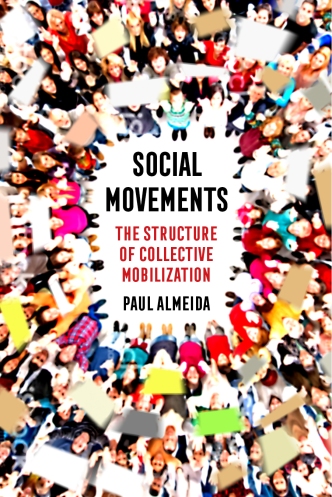Social Movements: The Structure of Collective Mobilization
Dr. Paul Almeida, University of California–Merced

Paul Almeida’s timely work, Social Movements: The Structure of Collective Mobilization, offers a new resource for scholars and community members interested in movements by excluded social groups and their fight for social change. Almeida’s work provides important lessons for students, scholars, and activists by discussing how movements emerge and the reasons individuals choose to participate in collective action.
Recent social movement studies have emphasized how threats, or negative conditions, play a fundamental role in mobilization. Even though there are increasing risks for participation, communities continue to mobilize locally and nationally against different types of threats. Almeida’s work brings to the forefront of movement scholarship and activism a precise classification of different forms of threats, including environmental, economic, and repressive threats and their corresponding contributions to popular mobilization. He organizes the text and chapters into some of the main themes or subfields of social movement research, namely, methods, theory, movement emergence, micro-mobilization and individual recruitment, framing, movement outcomes, and movement dynamics in the global South.
Another useful feature of the book is that it introduces readers to more recent movements such as the Fight for $15’s labor strikes and campaigns that give voice to people who are fighting for the right to a livable wage. There are also discussions on the fuel price hike protests in Mexico, immigrant rights, the Women’s Marches, movements in the Global South against privatization and other neoliberal economic policies, Global Climate Justice movements, and the recent Family Separation protests in order to bring concrete examples into the often abstract language of movement concepts and theories. This work not only informs our local communities about the movements daily citizens are engaging in for social change but can also be useful for community activists. One novel aspect of the book is how it examines protest music, which has been given less attention in framing analysis. Protest music is used by activists and musicians to highlight the grievances communities face and move people to join their local movements. Almeida also emphasizes the different combination of methods (e.g., ethnography, protest event analysis, surveys, archives, social media communication) we can use to study social movements at the various levels of collective action from everyday resistance to transnational social movements and how to determine whether a movement succeeds or fails. The book may even serve as a guide that could bring coalitions of people together to have necessary conversations about the role of movements and give hope for positive community change. Social Movements: The Structure of Collective Mobilization is a must read to anyone interested in everyday community struggles and the potential for social transformation.
A discount for Mobilizing Ideas readers is available HERE
For More Information:
https://www.ucpress.edu/book/9780520290914/social-movements
https://www.ucpress.edu/blog/41706/21-century-social-movements/

Pingback: Social Movements. Paul Almeida - LAOMS